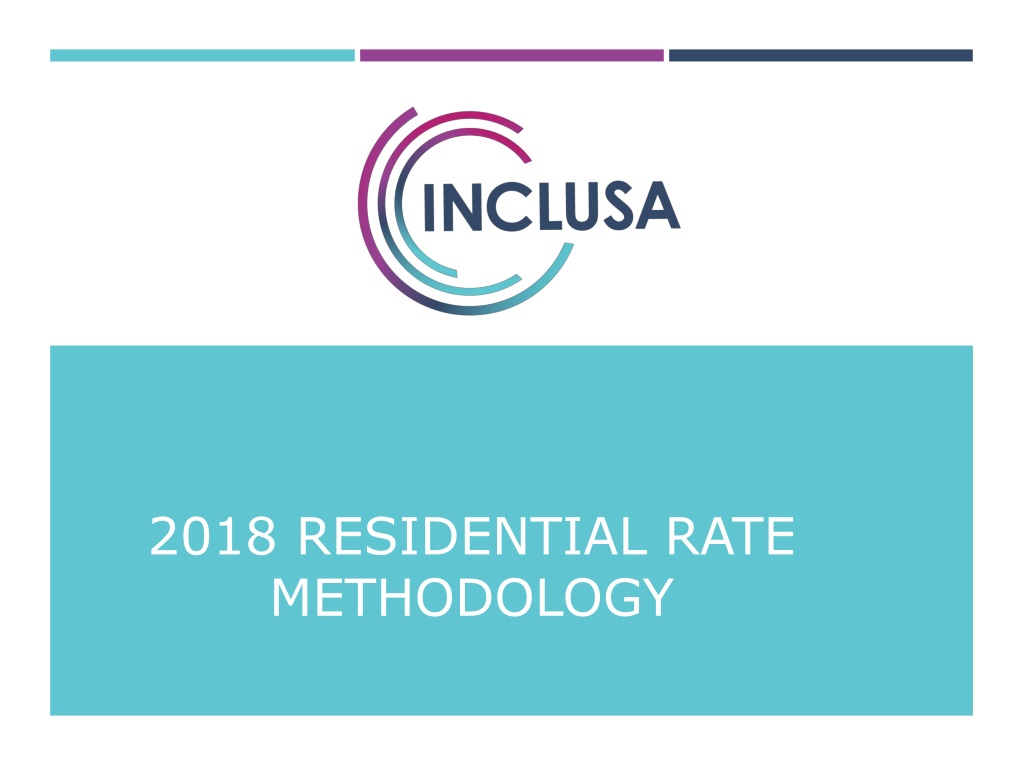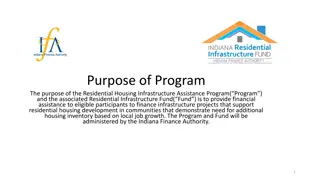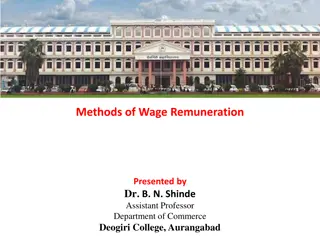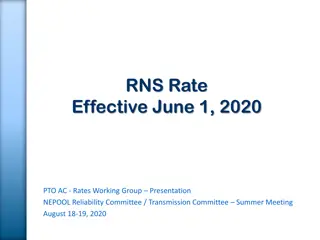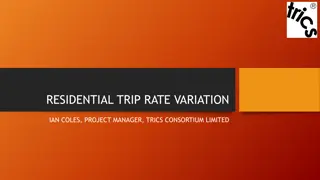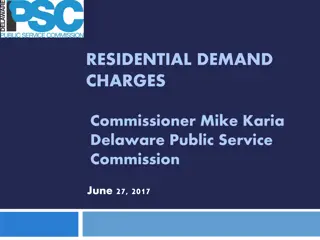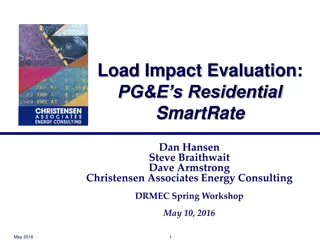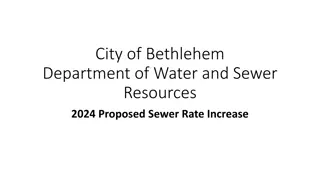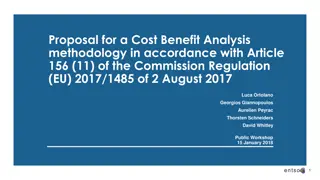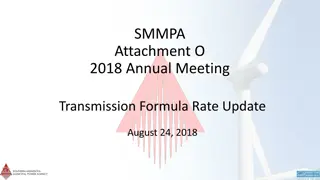2018 Residential Rate Methodology Overview
The 2018 Residential Rate Methodology introduces a new approach for determining care and supervision rates for residential placements. The timeline, benefits, key elements, and transition planning are explained. Considerations such as rate transparency, acuity bands, and outcome goals drive rate enhancements for 2019. The methodology includes components like member acuity, level of service, and outcomes. Provider feedback influenced the model to provide stability, predictability, and compensation for specialized care. Explore the new methodology for improved rate determination.
Download Presentation

Please find below an Image/Link to download the presentation.
The content on the website is provided AS IS for your information and personal use only. It may not be sold, licensed, or shared on other websites without obtaining consent from the author.If you encounter any issues during the download, it is possible that the publisher has removed the file from their server.
You are allowed to download the files provided on this website for personal or commercial use, subject to the condition that they are used lawfully. All files are the property of their respective owners.
The content on the website is provided AS IS for your information and personal use only. It may not be sold, licensed, or shared on other websites without obtaining consent from the author.
E N D
Presentation Transcript
2018 RESIDENTIAL RATE METHODOLOGY
OVERVIEW Timeline of the new Residential Rate Methodology roll-out Benefits of the new Residential Rate Methodology Residential Rate Methodology overview How rates are determined Future Outcome Payment options Rate and Category Review Processes Transition Planning
WHAT IS THE TIMELINE? The new Residential Rate Methodology will be used to establish care and supervision rates starting on January 1, 2018 for new residential placements and enrollments. A transition plan will be developed for care and supervision rates for currently existing placements to be moved into the new Residential Rate Methodology on January 1, 2018.
WHAT ARE THE BENEFITS? In identifying a new methodology, several considerations were made. These include: o Using a model that can be used for 90% of rates (non-outliers) o Aligning the member acuity score with the Department of Health Services regression model used to set MCO capitation rates o Creating acuity bands to reduce the impact of minor changes in acuity o Providing transparency as to how the rates are developed o Developing outcome goals for 2018 that will drive rate enhancements for 2019
WHAT ARE THE BENEFITS (CONT D) Additional considerations, based on provider feedback, were also built into the new model. o Providing more stability and predictability from year to year o Compensating for specialized or high level cares o Considering quality components, community involvement and member outcomes
WHAT ARE THE KEY ELEMENTS Residential Rate Methodology is comprised of 3 component areas: Acuity of Member Based upon the LTC Functional Screen Acuity of Member 2017 Level of Service 2017 Level of Service Includes services not captured within the Acuity of the member Outcomes Reimbursement opportunity for providers that meet established outcomes Outcomes 2018
WHAT ARE THE KEY ELEMENTS Acuity Component The Regression Model a holistic picture of the member, based on target group, multiple areas of the LTC Functional Screen, and determined cost drivers for the target group as developed by the State Acuity of Member 2017 Acuity Band Values The acuity numbers are added together for an overall acuity score. An acuity score falls into an acuity band Regression Percentage Based on averages and rate trends
WHAT ARE THE KEY ELEMENTS Provider Categories Based upon target group, average acuity of the members served, staffing model, overnight care, and behavioral/medical specialties Level of Service Component Ability to build in services offered that are above and beyond what is required and not included within the acuity portion of the rate Level of Service 2017 Example: Category change for providers that serve Advanced Dementia and Alzheimer s disease Ongoing evaluation of provider services to determine whether additional enhancements should be made
WHAT ARE THE KEY ELEMENTS New opportunity for providers to gain reimbursement based on offering an additional level of care through identified outcomes Outcome Component The criteria used to develop the outcomes to be utilized in 2019 include: o Both provider and member specific outcomes Outcomes 2019 o Outcomes that will be simplistic to measure and operationalize
TOOL OVERVIEW Key components of the tool: o Total Member Acuity based on DHS Target group-specific Regression Model o Acuity Band Value o Category of Residential Provider o Regression Percentage (based on averages and rate trends)
TOOL OVERVIEW (CONTD) Acuity Band Value: o The acuity numbers are added together for an overall acuity score. That acuity score falls into an acuity band. o Each acuity band is assigned a value to which a percentage is applied o The band value used is on the high end of the acuity range
TOOL OVERVIEW (CONTD) Category of the Residential Provider: o The model utilizes category assignments for each provider o Categories are determined based upon target group, average acuity of the members served, staffing model, overnight care, and behavioral/medical specialties o Includes category definition for providers that serve Advanced Dementia and Alzheimer s Disease o There are 5 Provider Categories in the current methodology o Your contract addendum will identify which category your facility(ies) are in
TOOL OVERVIEW (CONTD) A member with an acuity score of 310 would fall into the 300-349 acuity band. A band value of $3,400 is assigned Dependent upon the category of residential provider, the designated percentage is the amount of the regression value that is used to pay residential care and supervision Most members have other serviced provided beyond residential care and supervision
TOOL OVERVIEW (CONTD) Let s Calculate! Member s Acuity Band Value X Percentage = Monthly Care and Supervision Rate Divided by 30.4 (average days per month) = Daily Care and Supervision Rate
TOOL OVERVIEW (CONTD) A member with an acuity score of 310 would fall into the 300-349 acuity band. A band value of $3,400 is assigned If the member was in a Category 5 facility, the designated percentage of the amount of the regression value is 87% $3,400 x 87% = $2,958 (monthly) $2,958 / 30.4 = $97.30 Rounded = $97 Daily Rate
WHAT ARE OUTCOME-BASED PAYMENTS? In 2018, Inclusa will define the outcomes for providers that, if met, would result in an enhanced rate in 2019. Outcomes create opportunities for providers to gain reimbursement based on providing an additional level of care not captured within the acuity portion of the rate tool. The criteria used to develop the outcomes to be utilized in 2019 include: o Both provider and member specific outcomes o Outcomes that will be simplistic to measure and operationalize
WHAT ARE OUTCOME-BASED PAYMENTS? The outcomes will focus on: o Provider s Internal Quality Initiatives o Influenza Vaccination o Behavioral Support Planning o Employment/Community Involvement
RESIDENTIAL REVIEW TYPES Significant Change in Condition (CIC) Review Providers seeking a rate change due to a member s significant change in condition are reviewed on a weekly basis. Outlier Review Occurs when a member s support needs are unique and complex and fall outside of the residential rate methodology. This review will require providers to submit budgets and staffing information for each member. Provider Category Review Opportunity for providers to request a review if their services appear to be at a higher level than the category to which they were initially assigned.
QUESTIONS Jan Ash Jan.Ash@Inclusa.org 715-598-2448 Linnea Fiser Linnea.Fiser@Inclusa.org 608-785-3630 Becky Kuehl Rebecca.Kuehl@Inclusa.org 715-301-1652 Karla Lubinski Karla.Lubinski@Inclusa.org 608-785-9903
